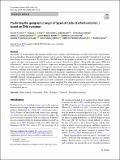Predicting the geographic origin of Spanish cedar (Cedrela odorata L.) based on DNA variation
Abstract
The legality of wood products often depends on their origin, creating a need for forensic tools that verify claims of provenance for wood products. The neotropical tree species Cedrela odorata (Spanish cedar) is economically valuable for its wood and faces threats of overexploitation. We developed a 140 SNP assay for geographic localization of C. odorata specimens. Target capture and short-read sequencing of 46 C. odorata specimens allowed us to identify 140 spatially informative SNPs that differentiate C. odorata specimens by latitude, temperature, and precipitation. We assessed the broad applicability of these SNPs on 356 specimens from eight Cedrela species, three tissue types, and a range of DNA mass inputs. Origin prediction error was evaluated with discrete and continuous spatial assignment methods focusing on C. odorata specimens. Discrete classification with random forests readily differentiated specimens originating in Central America versus South America (5.8% error), while uncertainty increased as specimens were divided into smaller regions. Continuous spatial prediction with SPASIBA showed a median prediction error of 188.7 km. Our results demonstrate that array SNPs and resulting genotypes accurately validate C. odorata geographic origin at the continental scale and show promise for country-level verification, but that finer-scale assignment likely requires denser spatial sampling. Our study underscores the important role of herbaria for developing genomic resources, and joins a growing list of studies that highlight the role of genomic tools for conservation of threatened species.
Citation
Finch , K N , Cronn , R C , Ayala Richter , M C , Blanc-Jolivet , C , Correa Guerrero , M C , De Stefano Beltrán , L , García-Dávila , C R , Honorio Coronado , E N , Palacios-Ramos , S , Paredes-Villanueva , K & Jones , F A 2020 , ' Predicting the geographic origin of Spanish cedar ( Cedrela odorata L.) based on DNA variation ' , Conservation Genetics , vol. 21 , no. 4 , pp. 625-639 . https://doi.org/10.1007/s10592-020-01282-6
Publication
Conservation Genetics
Status
Peer reviewed
ISSN
1566-0621Type
Journal article
Description
Funding for this study was provided by U. S. Agency for International Development (Award 19318814Y0010-140001) to the U.S. Forest Service International Programs, the U.S.D.A. Forest Service Pacific Northwest Research Station, and the Moldenke Endowment (Botany and Plant Pathology Department, Oregon State University).Collections
Items in the St Andrews Research Repository are protected by copyright, with all rights reserved, unless otherwise indicated.

